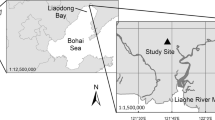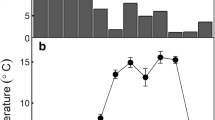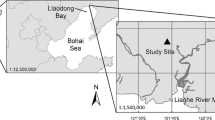Abstract
Foundation plant species play an important functional role in modifying microenvironment through vegetation structure and by influencing soil properties. Mangroves and salt marsh differ in vegetation structure, yet offer similar ecosystem services. This work aimed to understand how different vegetation classes and abiotic factors along a latitudinal gradient of spatial and temporal complexity affect soil CO2 efflux. Soil CO2 efflux, biomass, soil properties, and soil and air temperature were measured in July 2015 and January 2016 in situ at 10 sites along a 342-km latitudinal gradient on the Atlantic coast of Florida. Mean CO2 flux values ranged from 0.41 ± 0.19 to 2.03 ± 0.19 μmol m−2 s−1 across vegetation classes, and efflux values in mangrove plots were not significantly different between sampling dates, whereas ecotone and salt marsh efflux values were. On average, CO2 flux was 1.11 ± 0.18 μmol m−2 s−1 greater in July than in January across plots. There was no significant trend between efflux and aboveground biomass and a positive trend between belowground biomass and CO2 efflux. Edaphic parameters (organic matter content (%), soil N, organic C, and pH) were comparable across all vegetation class soils and there was a positive trend between soil temperature and flux. Soil efflux had an inverse relationship with latitude; in January, there is an increase in efflux with a decrease in latitude, while in July, efflux increases with an increase in latitude. Consequently, we assert that differences in CO2 efflux were due to soil temperature and species productivity along the latitudinal gradient studied.




Similar content being viewed by others
References
Alongi, D.M., J. Pfitzner, L.A. Trott, F. Tirendi, P. Dixon, and D.W. Klumpp. 2005. Rapid sediment accumulation and microbial mineralization in forests of the mangrove Kandelia candel in the Jiulongjiang estuary, China. Estuarine, Coastal and Shelf Science 63 (4): 605–618.
Alongi, D. 2009. The energetics of mangrove forests. Springer Science & Business Media. https://books.google.com/books?hl=en&lr=&id=tHM54IKQSv4C&oi=fnd&pg=PR3&dq=Alongi+2009&ots=snscJi797g&sig=33V7SjKG9N6BZDEKfUpZOaC3OXM#v=onepage&q=Alongi%202009&f=false
Alongi, D.M. 2014. Carbon cycling and storage in mangrove forests. Annual Review of Marine Science 6 (1): 195–219.
Bauer, J.E., W.J. Cai, P.A. Raymond, T.S. Bianchi, C.S. Hopkinson, and P.A. Regnier. 2013. The changing carbon cycle of the coastal ocean. Nature 504 (7478): 61–70.
Baustian, J.J., I.A. Mendelssohn, and M.W. Hester. 2012. Vegetation's importance in regulating surface elevation in a coastal salt marsh facing elevated rates of sea level rise. Global Change Biology 18 (11): 3377–3382.
Bouillon, S., A.V. Borges, E. Castañeda-Moya, K. Diele, T. Dittmar, N.C. Duke, E. Kristensen, S.Y. Lee, C. March and, J.J. Middelburg, V.H. Rivera-Monroy, T.J. Smith III, and R.R. Twilley. 2008. Mangrove production and carbon sinks: A revision of global budget estimates. Global Biogeochemical Cycles 22(2): 1–12.
Cavanaugh, K.C., J.R. Kellner, A.J. Forde, D.S. Gruner, J.D. Parker, W. Rodriguez, and I.C. Feller. 2014. Poleward expansion of mangroves is a threshold response to decreased frequency of extreme cold events. Proceedings of the National Academy of Sciences 111 (2): 723–727.
Chen, G.C., N.F.Y. Tam, and Y. Ye. 2010. Summer fluxes of atmospheric greenhouse gases N2O, CH4 and CO2 from mangrove soil in South China. Science of the Total Environment 408 (13): 2761–2767.
Chen, G.C., N.F. Tam, and Y. Ye. 2012. Spatial and seasonal variations of atmospheric N 2 O and CO 2 fluxes from a subtropical mangrove swamp and their relationships with soil characteristics. Soil Biology and Biochemistry 48: 175–181.
Chen, G.C., Y.I. Ulumuddin, S. Pramudji, S.Y. Chen, B. Chen, Y. Ye, D.Y. Ou, Z.Y. Ma, H. Huang, and J.K. Wang. 2014. Rich soil carbon and nitrogen but low atmospheric greenhouse gas fluxes from North Sulawesi mangrove swamps in Indonesia. Science of the Total Environment 487: 91–96.
Chen, G., B. Chen, D. Yu, N.F. Tam, Y. Ye, and S. Chen. 2016. Soil greenhouse gas emissions reduce the contribution of mangrove plants to the atmospheric cooling effect. Environmental Research Letters 11 (12): 124019.
Climate-Data.org. Köppen climatic classifications of Florida. https://en.climate-data.org/region/1000/ Accessed on August 31st, 2017.
Comas, L.H., and D.M. Eissenstat. 2004. Linking fine root traits to maximum potential growth rate among 11 mature temperate tree species. Functional Ecology 18 (3): 388–397.
Comeaux, R.S., M.A. Allison, T.S. Bianchi, and T.S. 2012. Mangrove expansion in the Gulf of Mexico with climate change: Implications for wetland health and resistance to rising sea levels. Estuarine, Coastal and Shelf Science 96: 81–95.
Couteaux, M.M., P. Bottner, and B. Berg. 1995. Litter decomposition, climate and liter quality. Trends in Ecology & Evolution 10 (2): 63–66.
Dias, A.T.C., J. Van Ruijven, and F. Berendse. 2010. Plant species richness regulates soil respiration through changes in productivity. Oecologia 163 (3): 805–813.
Donato, D.C., J.B. Kauffman, D. Murdiyarso, S. Kurnianto, M. Stidham, and M. Kanninen. 2011. Mangroves among the most carbon-rich forests in the tropics. Nature Geoscience 4 (5): 293–297.
Doughty, C.L., J.A. Langley, W.S. Walker, I.C. Feller, R. Schaub, and S.K. Chapman. 2016. Mangrove range expansion rapidly increases coastal wetland carbon storage. Estuaries and Coasts 39 (2): 385–396.
Geng, Y., Y. Wang, K. Yang, S. Wang, H. Zeng, F. Baumann, P. Kuehn, T. Scholten, and J.S. He. 2012. Soil respiration in Tibetan alpine grasslands: Belowground biomass and soil moisture, but not soil temperature, best explain the large-scale patterns. PloS one 7(4), p.e34968.
Glick, P., B.A. Stein, and N.A. Edelson. 2011. Scanning the conservation horizon: A guide to climate change vulnerability assessment, 168 p. Washington, DC: National Wildlife Federation.
Han, G., Q. Xing, Y. Luo, R. Rafique, J. Yu, and N. Mikle. 2014. Vegetation types alter soil respiration and its temperature sensitivity at the field scale in an estuary wetland. PLoS One 9 (3): e91182.
Hanson, P.J., N.T. Edwards, C.T. Garten, and J.A. Andrews. 2000. Separating root and soil microbial contributions to soil respiration: A review of methods and observations. Biogeochemistry 48 (1): 115–146.
Harden, J.W., J. Sanderman, and G. Hugelius. 2017. Soils and the Carbon Cycle. In Soils and the carbon cycle. The International Encyclopedia of Geography.
Henry, K.M., and R.R. Twilley. 2013. Soil development in a coastal Louisiana wetland during a climate-induced vegetation shift from salt-marsh to mangrove. Journal of Coastal Research 29 (6): 1273–1283.
Hopkinson, C.S., J.G. Gosselink, and R.T. Parrando. 1978. Aboveground production of seven marsh plant species in coastal Louisiana. Ecology 59 (4): 760–769.
Howarth, R.W., and J.M. Teal. 1979. Sulfate reduction in a New England salt marsh. Limnology 24.
Howes, B.L., J.W.H. Dacey, and J.M. Teal. 1985. Annual carbon mineralization and belowground production of Spartina alterniflora in a New England salt marsh. Ecology 66 (2): 595–605.
Howes, B.L., J.W.H. Dacey, and D.D. Goehringer. 1986. Factors controlling the growth form of Spartina alterniflora: feedbacks between above-ground production, sediment oxidation, nitrogen and salinity. The Journal of Ecology 881–898.
Inglett, K.S., P.W. Inglett, and R.K. Reddy. 2011. Soil microbial community composition in a restored calcareous subtropical wetland. Soil Science Society of America Journal 75 (5): 1731–1740.
IPCC 2014. Field, C.B., V.R. Barros, D.J. Dokken, K.J. Mach, M.D. Mastrandrea, T.E. Bilir, and B. Girma. 2014. Climate change 2014: Impacts, adaptation, and vulnerability. Part A: Global and Sectoral Aspects. Contribution of Working Group II to the Fifth Assessment Report of the Intergovernmental Panel on Climate Change. 1132.
Jackson, R.B., C.W. Cook, J.S. Pippen, and S.M. Palmer. 2009. Increased belowground biomass and soil CO2 fluxes after a decade of carbon dioxide enrichment in a warm-temperate forest. Ecology 90 (12): 3352–3366.
Jobbágy, E.G., and R.B. Jackson. 2000. The vertical distribution of soil organic carbon and its relation to climate and vegetation. Ecological Applications 10 (2): 423–436.
Kirwan, M.L., and L.K. Blum. 2011. Enhanced decomposition offsets enhanced productivity and soil carbon accumulation in coastal wetlands responding to climate change. Biogeosciences 8 (4): 987–993.
Komiyama, A., J.E. Ong, and S. Poungparn. 2008. Allometry, biomass, and productivity of mangrove forests: A review. Aquatic Botany 89 (2): 128–137.
Kristensen, E., S. Bouillon, T. Dittmar, and C. Marchand. 2008. Organic carbon dynamics in mangrove ecosystems: A review. Aquatic Botany 89 (2): 201–209.
Leopold, A., C. Marchand, J. Deborde, C. Chaduteau, and M. Allenbach. 2013. Influence of mangrove zonation on CO 2 fluxes at the sediment–air interface (New Caledonia). Geoderma 202: 62–70.
Leopold, A., C. Marchand, J. Deborde, and M. Allenbach. 2015. Temporal variability of CO2 fluxes at the sediment-air interface in mangroves (New Caledonia). Science of the Total Environment 502: 617–626.
Lewis, D.B., J.A. Brown, and K.L. Jimenez. 2014. Effects of flooding and warming on soil organic matter mineralization in Avicennia germinans mangrove forests and Juncus roemerianus salt-marshes. Estuarine, Coastal and Shelf Science 139: 11–19.
Liang, J.I.N., L.U. Chang-Yi, Y.E. Yong, and Y.E. Gong-Fu. 2013. Soil effluxin a subtropical mangrove wetland in the Jiulong River estuary, China. Pedosphere 23 (5): 678–685.
LI-COR Inc. 2003. 6400–09 Soil CO2 Flux Chamber Instruction Manual. https://www.licor.com/documents/iqpbvjolxbhrf52mlimp
Lovelock, C.E., R.W. Ruess, and I.C. Feller. 2006. Fine root respiration in the mangrove Rhizophora mangle over variation in forest stature and nutrient availability. Tree Physiology 26 (12): 1601–1606.
Lovelock, C.E. 2008. Soil respiration and belowground carbon allocation in mangrove forests. Ecosystems 11 (2): 342–354.
Lynch, J.M., A. Benedetti, H. Insam, M.P. Nuti, K. Smalla, V. Torsvik, and P. Nannipieri. 2004. Microbial diversity in soil: Ecological theories, the contribution of molecular techniques and the impact of transgenic plants and transgenic microorganisms. Biology and Fertility of Soils 40 (6): 363–385.
Maestre, F.T., and J. Cortina. 2003. Small-scale spatial variation in soil CO2 efflux in a Mediterranean semiarid steppe. Applied Soil Ecology 23 (3): 199–209.
Maier, M., H. Schack-Kirchner, E.E. Hildebrand, and D. Schindler. 2011. Soil CO2 efflux vs. soil respiration: Implications for flux models. Agricultural and Forest Meteorology 151 (12): 1723–1730.
McKee, K.L., I.A. Mendelssohn, and M.W. Hester. 1988. Reexamination of pore water sulfide concentrations and redox potentials near the aerial roots of Rhizophora mangle and Avicennia germinans. American Journal of Botany 75 (9): 1352–1359.
Mooshammer, M., W. Wanek, J. Schnecker, B. Wild, S. Leitner, F. Hofhansl, and K.M. Keiblinger. 2012. Stoichiometric controls of nitrogen and phosphorus cycling in decomposing beech leaf litter. Ecology 93 (4): 770–782.
Osland, M.J., N. Enwright, R.H. Day, and T.W. Doyle. 2013. Winter climate change and coastal wetland foundation species: Salt-marshes vs. mangrove forests in the southeastern United States. Global Change Biology 19 (5): 1482–1494.
Patterson, C.S., and I.A. Mendelssohn. 1991. A comparison of physicochemical variables across plant zones in a mangal/salt marsh community in Louisiana. Wetlands 11 (1): 139–161.
Perry, C.L., and I.A. Mendelssohn. 2009. Ecosystem effects of expanding populations of Avicennia germinans in a Louisiana salt-marsh. Wetlands 29 (1): 396–406.
Poungparn, S., A. Komiyama, A. Tanaka, T. Sangtiean, C. Maknual, S. Kato, and P. Patanaponpaiboon. 2009. Carbon dioxide emission through soil respiration in a secondary mangrove forest of eastern Thailand. Journal of Tropical Ecology 25 (4): 393–400.
Pregitzer, K.S., J.L. DeForest, A.J. Burton, M.F. Allen, R.W. Ruess, and R.L. Hendrick. 2002. Fine root architecture of nine north American trees. Ecological Monographs 72 (2): 293–309.
Pülmanns, N., K. Diele, U. Mehlig, and I. Nordhaus. 2014. Burrows of the semi-terrestrial crab Ucides cordatus enhance CO2 relases in a north Brazilian mangrove forest. PLoS One 9 (10): e109532. https://doi.org/10.1371/journal.pone.0109532.
Raich, J.W., and W.H. Schlesinger. 1992. The global carbon dioxide flux in soil respiration and its relationship to vegetation and climate. Tellus B 44 (2): 81–99.
Raich, J.W., A.E. Russell, and P.M. Vitousek. 1997. Primary productivity and ecosystem development along an elevational gradient on Mauna Loa, Hawai‘i. Ecology 78 (3): 707–721.
Reddy, K.R., and R.D. DeLaune. 2008. Biogeochemistry of wetlands: Science and applications. Boca Raton, Florida: CRC press.
Rees, A.T., M.M. Burrell, T.G. Entwistle, J.B. Hammond, D. Kirk, and N.J. Kruger. 1988. Effects of low temperature on the respiratory metabolism of carbohydrates by plants. In Symposia of the Society for Experimental Biology 42: 377–393.
Reichstein, M., A. Rey, A. Freibauer, J. Tenhunen, R. Valentini, J. Banza, and R. Joffre. 2003. Modeling temporal and large scale spatial variability of soil respiration from soil water availability, temperature and vegetation productivity indices. Global Biogeochemical Cycles 17 (4).
Roland, M., S. Vicca, M. Bahn, T. Ladreiter-Knauss, M. Schmitt, and I.A. Janssens. 2015. Importance of nondiffusive transport for soil CO2 efflux in a temperate mountain grassland. Journal of Geophysical Research: Biogeosciences 120 (3): 502–512.
Schlesinger, W.H., and J.A. Andrews. 2000. Soil respiration and the global carbon cycle. Biogeochemistry 48 (1): 7–20.
Shi, P.L., X.Z. Zhang, Z.M. Zhong, and H. Ouyang. 2006. Diurnal and seasonal variability of soil CO2 efflux in a cropland ecosystem on the Tibetan plateau. Agricultural and Forest Meteorology 137 (3): 220–233.
Simpson, L.T., T.Z. Osborne, L.J. Duckett, and I.C. Feller. 2017. Carbon storages along a climate induced coastal wetland gradient. Wetlands 1-13.
Stein, B.A., P. Glick, N.A. Edelson, and A. Staudt. 2014. Climate-smart conservation: Putting adaptation principles into practice. Washington, DC: National Wildlife Federation.
Strickland, M.S., C. Lauber, N. Fierer, and M.A. Bradford. 2009. Testing the functional significance of microbial community composition. Ecology 90 (2): 441–451.
Teal, J.M., and B.L. Howes. 1996. Interannual variability of a salt-marsh ecosystem. Limnology and Oceanography 41 (4): 802–809.
Tomlinson, P.B. 1986. The botany of mangroves. Cambridge: Cambridge University Press. https://books.google.com/books/about/The_Botany_of_Mangroves.html?id=uwT6SMY-oNAC, 419p.
Turner, R.E., B.L. Howes, J.M. Teal, C.S. Milan, E.M. Swenson, and D.D. Goehringer-Toner. 2009. Salt marshes and eutrophication: An unsustainable outcome. Limnology and Oceanography 54 (5): 1634–1642.
Troxler, T.G., J.G. Barr, J.D. Fuentes, V. Engel, G. Anderson, C. Sanchez, C., and S.E. Davis. 2015. Component-specific dynamics of riverine mangrove CO2 efflux in the Florida coastal Everglades. Agricultural and Forest Meteorology 213: 273–282.
Twilley, R.R., R.H. Chen, and T. Hargis. 1992. Carbon sinks in mangroves and their implications to carbon budget of tropical coastal ecosystems. Water, Air, and Soil Pollution 64 (1–2): 265–288.
Wang, L., P. D'Odorico, S. Manzoni, A. Porporato, and S. Macko. 2009. Carbon and nitrogen dynamics in southern African savannas: The effect of vegetation-induced patch-scale heterogeneities and large scale rainfall gradients. Climatic Change 94 (1-2): 63–76.
Zheng, D., E.R. Hunt Jr, and S.W. Running. 1993. A daily soil temperature model based on air temperature and precipitation for continental applications. Climate Research 183-191.
Acknowledgements
The authors would like to thank Florida State Parks, the Merritt Island National Wildlife Refuge, Guana–Tolmato–Matanzas National Estuarine Research Reserve, and Canaveral National Seashore for permits and unabridged access to their parks. We also thank L.J. Duckett, M.L. Lehmann, and Z.R. Foltz for field and lab assistance, and S.K. Chapman and two anonymous reviewers for their edits and suggestions, which greatly improved this manuscript. This is contribution no. 1088 of the Smithsonian Marine Station.
Funding
This research was funded by the National Aeronautics and Space Administration (NASA) Climate and Biological Response program (NNX11AO94G) and the National Science Foundation (NSF) MacroSystems Biology program (EF1065821).
Author information
Authors and Affiliations
Corresponding author
Additional information
Communicated by Dennis Swaney
Electronic supplementary material
Supplementary Table 1
(DOC 31 kb)
Rights and permissions
About this article
Cite this article
Simpson, L., Osborne, T.Z. & Feller, I.C. Wetland Soil Co2 Efflux Along a Latitudinal Gradient of Spatial and Temporal Complexity. Estuaries and Coasts 42, 45–54 (2019). https://doi.org/10.1007/s12237-018-0442-3
Received:
Revised:
Accepted:
Published:
Issue Date:
DOI: https://doi.org/10.1007/s12237-018-0442-3




